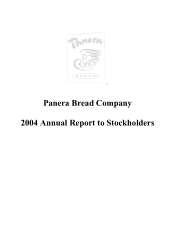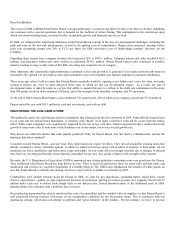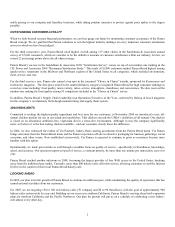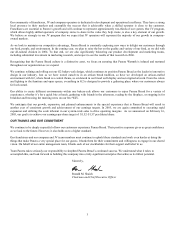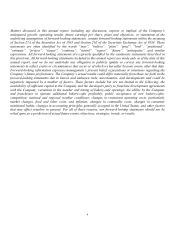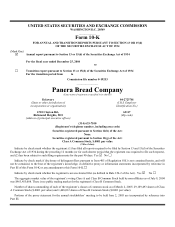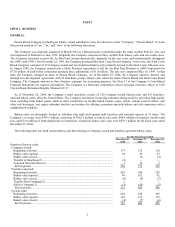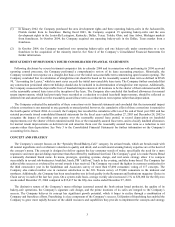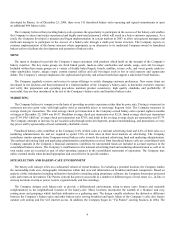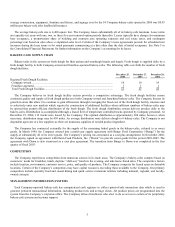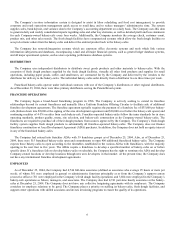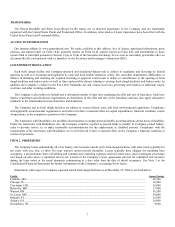Panera Bread 2004 Annual Report Download - page 3
Download and view the complete annual report
Please find page 3 of the 2004 Panera Bread annual report below. You can navigate through the pages in the report by either clicking on the pages listed below, or by using the keyword search tool below to find specific information within the annual report.Dear Stockholders:
The events of 2004 confirmed that Panera Bread’s strong performance is rooted in our ability to deliver on what we do best: delighting
our customers with a special experience that is founded on the tradition of artisan baking. This commitment is the cornerstone upon
which our award-winning menu, customer loyalty, remarkable growth, and financial success are built.
In 2004, we witnessed the underlying robustness of the Panera Bread concept in the face of environmental challenges, including the
peak and wane of the low-carb phenomenon, as well as the spiking costs of commodities. Despite these pressures, earnings before
prior year accounting change rose 24% to $1.25 per share, the fifth consecutive year of double-digit earnings’ increases for the
Company.
Propelling these returns were company revenues that increased 32% to $479.1 million. Company bakery-cafe sales reached $362.1
million, and franchisee bakery-cafe sales totaled an additional $879.1 million. Panera Bread bakery-cafes continued to produce
industry-leading average weekly sales of $36,008, exceeding any competitor in our category.
Most important, this consistently high performance continued to fuel unit growth as it generated very steady cash-on-cash return on
investment. We opened 143 new bakery-cafes and continued to win several number-one industry rankings in customer satisfaction.
Three years ago, when I told investors that Panera Bread essentially would be opening a new bakery-cafe every few days, not many
seemed to believe me. Now we have delivered three years in which we met our development targets. As a result, our rate of
development today is taken by many as a given. Our ability to sustain this pace is a tribute to the skills and commitment of the more
than 100 people involved in development at Panera, and to the strength of our franchise, company, and JV operations.
At the end of 2004, Panera Bread bakery-cafes numbered 741 system-wide, 226 of which were company-owned and 515 franchised.
Panera ended the year with $58.1 million in cash and investments, and with no debt.
WEATHERING THE LOW-CARB STORM
Throughout the quick rise and ultimate decline in popularity that characterized the low-carb trend in 2004, Panera Bread remained true
to our roots and our artisan bread foundation. A company with “bread” in its name could have expected far worse from the Atkins
effect. While some companies were significantly impacted by the rise in low-carb diets, Panera experienced only a moderation in the
growth of same-store sales. It took some of the frothiness out of our comps, but not our overall growth rate.
Why did we not suffer the demise that some pundits predicted? Why, for Panera Bread, was this merely a thunderstorm, and not the
hurricane that others endured?
Customers trusted Panera Bread—and our food. They appreciated our respect for them. They moved around the existing menu that
already contained a variety of healthy options, to which we added several new lower-carb products in response to their needs. As our
customers ate fewer sandwiches and chose more soups and salads, we saw some effect on margin structure due to changes in internal
mix; however, we emerged from the storm relatively unscathed. In our view, this speaks volumes to the strength of the concept.
Recently, the U.S. Department of Agriculture (USDA) announced new dietary guidelines containing some very good news for Panera.
They reaffirmed what Panera Bread has long held to be true: There is good fat and bad fat, there are good carbs and bad carbs, and
moderation and exercise are essential components in a healthy lifestyle. The USDA also emphasized the benefits of whole grains, an
area that Panera Bread is currently developing, which we expect will be available to customers in 2005.
Commodities were another pressure point for Panera in 2004. As costs for key ingredients—including butter, liquid dairy (cream
cheese), and proteins—spiked, we also experienced increases in fuel prices, placing even more pressure on a company that travels 12
million miles each year to deliver fresh dough daily to our bakery-cafes. Panera absorbed much of the additional costs in 2004,
passing along to the customer only a moderate price increase.
Our purchasing department has closely monitored the costs of commodities and has worked with our suppliers so that Panera Bread is
well positioned moving forward, with many of our commodities stabilized for the foreseeable future. This is consistent with our
purchasing strategy, which does not attempt to optimize and “guess bottoms” in the markets. On the contrary, we strive to provide

